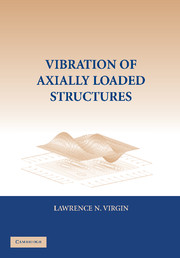Book contents
- Frontmatter
- Contents
- Foreword
- Preface
- 1 Context: The Point of Departure
- 2 Elements of Classical Mechanics
- 3 Dynamics in the Vicinity of Equilibrium
- 4 Higher-Order Systems
- 5 Discrete-Link Models
- 6 Strings, Cables, and Membranes
- 7 Continuous Struts
- 8 Other Column-Type Structures
- 9 Frames
- 10 Plates
- 11 Nondestructive Testing
- 12 Highly Deformed Structures
- 13 Suddenly Applied Loads
- 14 Harmonic Loading: Parametric Excitation
- 15 Harmonic Loading: Transverse Excitation
- 16 Nonlinear Vibration
- Index
- Plate section
16 - Nonlinear Vibration
Published online by Cambridge University Press: 05 May 2010
- Frontmatter
- Contents
- Foreword
- Preface
- 1 Context: The Point of Departure
- 2 Elements of Classical Mechanics
- 3 Dynamics in the Vicinity of Equilibrium
- 4 Higher-Order Systems
- 5 Discrete-Link Models
- 6 Strings, Cables, and Membranes
- 7 Continuous Struts
- 8 Other Column-Type Structures
- 9 Frames
- 10 Plates
- 11 Nondestructive Testing
- 12 Highly Deformed Structures
- 13 Suddenly Applied Loads
- 14 Harmonic Loading: Parametric Excitation
- 15 Harmonic Loading: Transverse Excitation
- 16 Nonlinear Vibration
- Index
- Plate section
Summary
PART I: FREE VIBRATION
Introduction
This last chapter considers the dynamic response of axially loaded structural systems in which the motion is not necessarily confined to the local vicinity of an underlying equilibrium position and dynamic behavior is not necessarily harmonic. In a number of places throughout this book, a statement has been made to the effect that largeamplitude behavior will be described later. We now finally consider such situations, largely in terms of revisiting examples detailed in earlier examples, but now, not relying on certain restrictions, for example, linear, or small-amplitude, behavior. Both free and forced vibrations will be considered.
By way of a simple introduction, we go back to the softening cable example described in Section 3.5, and specifically consider the context of Fig. 3.12. This is a free vibration started (with initial conditions) some distance from any of the three available stable equilibrium points present at this level of loading. Because there is no damping, the total energy is conserved, and thus phase trajectories can be viewed as contours of constant total energy. Figure 16.1(a) illustrates the energy levels as a contour plot, and thus we can view the phase trajectory of Fig. 3.12 living in the second darkest shade within the contours of Fig. 16.1(a). Parts (b)–(d) give specific examples of time series generated (numerically) by different initial conditions. We see that the time series in part (b), which corresponds to the phase trajectory shown in Fig. 3.12, is far from sinusoidal. The time series shown in part (c) has relatively small amplitude with a natural frequency close to that predicted by linear theory; see Fig. 3.2 (but still slightly nonlinear; note the expanded y-axis).
Information
- Type
- Chapter
- Information
- Vibration of Axially-Loaded Structures , pp. 312 - 346Publisher: Cambridge University PressPrint publication year: 2007
